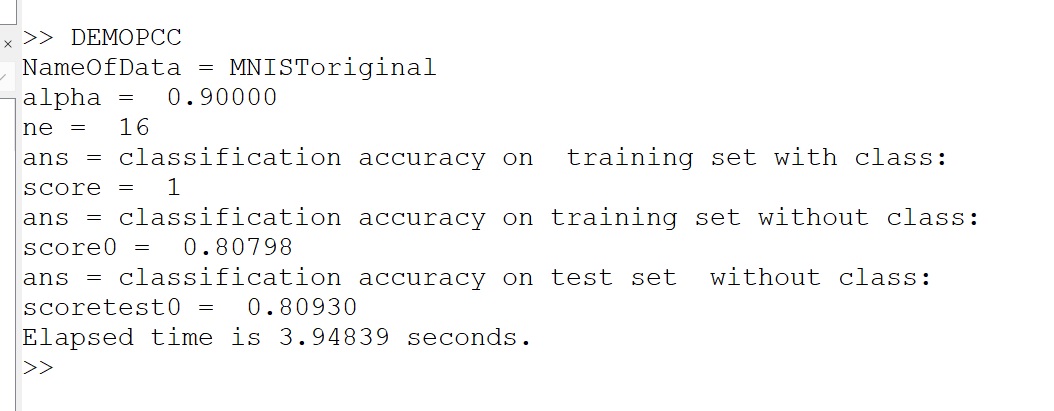This package contains Matlab code associated with the following publication:
ArXiv:2210.12746 Please cite this paper when using this code.
Demo is launched by typing in the command window of Matlab (or Octave):
DEMOPCC
Choice of the dataset can be changed by editing that file header: it is currently set to process the original MNIST dataset
%% Read Data / comment as appropriate
NameOfData='MNISToriginal' % original split Xtrain 60000 and Xtest 10000
% NameOfData='MNIST10'
% NameOfData='wine'
% NameOfData='australian'
Example of output for MNISToriginal obtained with Octave
The model run by default on MNISToriginal uses 16 principal components and as set
When processing dataset MNIST10, the demo creates some figures but not all work with Octave.
MNIST is downloaded from https://github.com/daniel-e/mnist_octave/raw/master/mnist.mat
Datasets wine and australian are downloaded from https://github.com/PouriaZ/GMML
In supervised learning, we consider available a dataset
concatenating vectors
Principal Components are then used for classification even if no class information is available at test time to process a new input
Random permutation training/test sets are used on australian and wine dataset so results change at every run: average over 10 runs is reported here:
| Dataset | nb of components |
alpha |
Accuracy (test set) |
|---|---|---|---|
MNISToriginal |
16 | 0.9 | 0.80930 |
MNISToriginal |
618 | 0.02 | 0.85410 |
australian |
4 | 0.2 | ~0.76 |
australian |
5 | 0.2 | ~0.84 |
wine |
4 | 0.2 | ~0.88 |
wine |
5 | 0.2 | ~0.92 |
The number of principal components, and the scalar MNIST10 (see paper). These images were created with a for loops computing classification accuracy on a grid defined on the hyperparameter space (code not provided).
@techreport{Dahyot_PCC2022,
author = {Dahyot, Rozenn},
keywords = {Supervised Learning, PCA, classification, metric learning, deep learning, class encoding},
abstract={We propose to directly compute classification estimates
by learning features encoded with their class scores.
Our resulting model has a encoder-decoder structure suitable for supervised learning, it is computationally efficient and performs well for classification on several datasets.},
title = {Principal Component Classification},
publisher = {arXiv},
year = {2022},
doi = {10.48550/ARXIV.2210.12746},
url = {https://arxiv.org/pdf/2210.12746.pdf},
}








